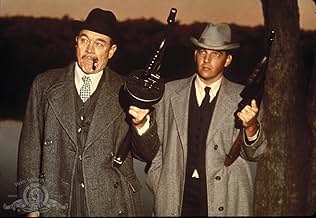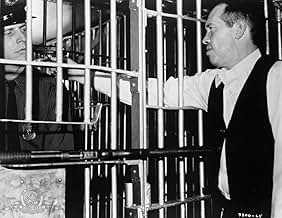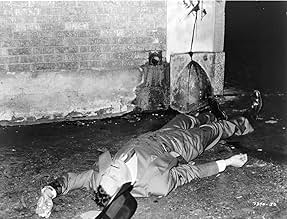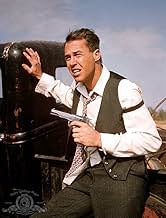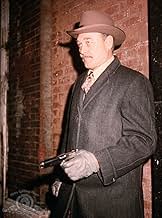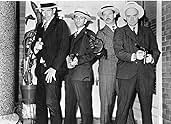IMDb-BEWERTUNG
6,9/10
6242
IHRE BEWERTUNG
John Dillinger und seine Bande begeben sich auf einen Bankraub im Mittleren Westen.John Dillinger und seine Bande begeben sich auf einen Bankraub im Mittleren Westen.John Dillinger und seine Bande begeben sich auf einen Bankraub im Mittleren Westen.
- Auszeichnungen
- 1 Nominierung insgesamt
John P. Ryan
- Charles Mackley
- (as John Ryan)
Jules Brenner
- Wilbur Underhill
- (Nicht genannt)
David Dorr
- Leroy
- (Nicht genannt)
Roland Bob Harris
- Ed Fulton
- (Nicht genannt)
George O. Heath
- John Dillinger, Sr.
- (Nicht genannt)
Empfohlene Bewertungen
Like his predecessor in this role (Lawrence Tierney), this John Dillinger - Warren Oates - also looks the part. Oates is a rough-looking ugly mug and convincing in the lead role. Speaking of mugs, also included in this gangster flick are a few other criminals of the era: Baby Face Nelson and Pretty Boy Floyd.
Ben Johnson, meanwhile, is interesting as Melvin Purvis, the FBI who tracks down the famous Public Enemy Number One. Johnson also narrates in part of the film.
Oates does a fine job of playing Dillinger. Unfortunately - remember this is the '70s, a decade in which the "anti-hero" was a full bloom - the film tends to make this crook into a sympathetic figure. The screenwriters tell us, "Hey, folks, see this criminal really wasn't a bad guy! Gve him some slack!" Yeah, right.
A few minor acting notes: Cloris Leachman gets third billing, but only has a small role at the end as the famous "Lady In Red." Michelle Phillips, who made a name for herself as a member of the Mamas and Papas singing group, did a nice job of acting, better than I would have expected.
I have seen three versions of "Dillinger" and all of them are good, including this one.
Ben Johnson, meanwhile, is interesting as Melvin Purvis, the FBI who tracks down the famous Public Enemy Number One. Johnson also narrates in part of the film.
Oates does a fine job of playing Dillinger. Unfortunately - remember this is the '70s, a decade in which the "anti-hero" was a full bloom - the film tends to make this crook into a sympathetic figure. The screenwriters tell us, "Hey, folks, see this criminal really wasn't a bad guy! Gve him some slack!" Yeah, right.
A few minor acting notes: Cloris Leachman gets third billing, but only has a small role at the end as the famous "Lady In Red." Michelle Phillips, who made a name for herself as a member of the Mamas and Papas singing group, did a nice job of acting, better than I would have expected.
I have seen three versions of "Dillinger" and all of them are good, including this one.
John Dillinger (Warren Oates) and his gang go on a bank robbing spree across the Midwest, but one G-Man (Ben Johnson) is determined to bring him down.
Following "Bonnie and Clyde" and "The Wild Bunch", American International Pictures wanted their own violent gangster film. Producer Sam Arkoff hired the then-unknown writer John Milius to construct the script. An earlier, very rough version of the script had come in to producer Lawrence Gordon, and Gordon thought Milius – his former assistant -- would be right for the job.
A little research and a solid script would make this an excellent story, but those involved went one step better. Retired FBI Agent Clarence O. Hurt (1897-1975), one of the agents involved in the final shootout with Dillinger, was the film's technical adviser. Hurt had a distinguished career in the gangster era, also being one of the men who brought in Alvin "Creepy" Karpis. Interestingly, Hurt's house was burgled during his funeral – the newspapers liked to say this was the underworld's belated revenge.
In order to save money (Arkoff was always cutting corners), Milius was also offered the director's chair so that AIP would only have to pay one man rather than two. Gordon says this was his idea, but either way the reason was the same. Milius used John Ford as his inspiration, and if you pay close attention you will see homages to Ford's "My Darling Clementine".
The casting of Oates was pure perfection. Although many actors have portrayed John Dillinger before and since, Oates actually resembles the man for the most part. Singer Michelle Phillips as Billie Frechette, Dillinger's girlfriend, came about by an old Hollywood trick: lying. Phillips had told the producers she was half Indian to land her first acting gig.
Arkoff wrote in his autobiography of the ways they saved money on this one; besides the use of Milius, AIP was also selling off the cars after the shoot. So any money they may have spent during filming was in some way regained, even before the first frame hit the movie screens! The script's attention to facts is impressive. Sure, there are some liberties with Melvin Purvis, having him personally strike down more gangsters than he did. And the Little Bohemia Lodge has a few more casualties than it should have, not to mention some guests who weren't really there. By and large, the changes are minor and can easily be dismissed as a way to make the story simpler and more exciting. Having one FBI agent as the hero rather than a dozen is easily to plot out. At least the plot was not a complete fabrication like "Bonnie and Clyde" was; and still, that film is the one that gets more credit.
Upon release, it was inevitable that "Dillinger" would be compared to other gangster films, especially the identically-named "Dillinger" (1945). Dejan Ognjanovic calls Milius' film "the definitive version of the Dillinger story", and he is right. Ognjanovic also rightly notes that Milius paints his characters as mythical beings, larger than life, though the line between good and evil is often blurry. Carlos Clarens wrote that Milius' version "was considerably more romantic" than the 1945 film, despite the "carefully rigged bullet wounds and spurting blood." If nothing else, "Dillinger" deserves some recognition for its role in history: giving John Milius his directorial debut. AIP, especially through Sam Arkoff and Roger Corman, had given rise to numerous filmmakers from Jonathan Demme to Jack Nicholson to James Cameron. Milius may be lesser-known outside of cinephile circles, but his movies are larger than life: "Apocalypse Now", "Red Dawn" and the under-appreciated "Big Wednesday". Lawrence Gordon's career also took off at this point; his cost-cutting measures landed him a gig at 20th Century Fox, where hewent on to specialize in action films such as "Die Hard" and "Predator".
Arrow Video's 2016 blu-ray release gives this film the royal treatment. We have audio commentary by Stephen Prince, the author of "Savage Cinema" and "Screening Violence" (among others), who is an expert on both the violent film genres and gangster history. We also have brand new interviews with producer Lawrence Gordon, director of photography Jules Brenner, and composer Barry De Vorzon. Not enough? There is also a collector s booklet containing new writing by Kim Newman on fictional portrayals of John Dillinger, plus an on-set report containing interviews with writer-director John Milius, illustrated with original production stills.
Following "Bonnie and Clyde" and "The Wild Bunch", American International Pictures wanted their own violent gangster film. Producer Sam Arkoff hired the then-unknown writer John Milius to construct the script. An earlier, very rough version of the script had come in to producer Lawrence Gordon, and Gordon thought Milius – his former assistant -- would be right for the job.
A little research and a solid script would make this an excellent story, but those involved went one step better. Retired FBI Agent Clarence O. Hurt (1897-1975), one of the agents involved in the final shootout with Dillinger, was the film's technical adviser. Hurt had a distinguished career in the gangster era, also being one of the men who brought in Alvin "Creepy" Karpis. Interestingly, Hurt's house was burgled during his funeral – the newspapers liked to say this was the underworld's belated revenge.
In order to save money (Arkoff was always cutting corners), Milius was also offered the director's chair so that AIP would only have to pay one man rather than two. Gordon says this was his idea, but either way the reason was the same. Milius used John Ford as his inspiration, and if you pay close attention you will see homages to Ford's "My Darling Clementine".
The casting of Oates was pure perfection. Although many actors have portrayed John Dillinger before and since, Oates actually resembles the man for the most part. Singer Michelle Phillips as Billie Frechette, Dillinger's girlfriend, came about by an old Hollywood trick: lying. Phillips had told the producers she was half Indian to land her first acting gig.
Arkoff wrote in his autobiography of the ways they saved money on this one; besides the use of Milius, AIP was also selling off the cars after the shoot. So any money they may have spent during filming was in some way regained, even before the first frame hit the movie screens! The script's attention to facts is impressive. Sure, there are some liberties with Melvin Purvis, having him personally strike down more gangsters than he did. And the Little Bohemia Lodge has a few more casualties than it should have, not to mention some guests who weren't really there. By and large, the changes are minor and can easily be dismissed as a way to make the story simpler and more exciting. Having one FBI agent as the hero rather than a dozen is easily to plot out. At least the plot was not a complete fabrication like "Bonnie and Clyde" was; and still, that film is the one that gets more credit.
Upon release, it was inevitable that "Dillinger" would be compared to other gangster films, especially the identically-named "Dillinger" (1945). Dejan Ognjanovic calls Milius' film "the definitive version of the Dillinger story", and he is right. Ognjanovic also rightly notes that Milius paints his characters as mythical beings, larger than life, though the line between good and evil is often blurry. Carlos Clarens wrote that Milius' version "was considerably more romantic" than the 1945 film, despite the "carefully rigged bullet wounds and spurting blood." If nothing else, "Dillinger" deserves some recognition for its role in history: giving John Milius his directorial debut. AIP, especially through Sam Arkoff and Roger Corman, had given rise to numerous filmmakers from Jonathan Demme to Jack Nicholson to James Cameron. Milius may be lesser-known outside of cinephile circles, but his movies are larger than life: "Apocalypse Now", "Red Dawn" and the under-appreciated "Big Wednesday". Lawrence Gordon's career also took off at this point; his cost-cutting measures landed him a gig at 20th Century Fox, where hewent on to specialize in action films such as "Die Hard" and "Predator".
Arrow Video's 2016 blu-ray release gives this film the royal treatment. We have audio commentary by Stephen Prince, the author of "Savage Cinema" and "Screening Violence" (among others), who is an expert on both the violent film genres and gangster history. We also have brand new interviews with producer Lawrence Gordon, director of photography Jules Brenner, and composer Barry De Vorzon. Not enough? There is also a collector s booklet containing new writing by Kim Newman on fictional portrayals of John Dillinger, plus an on-set report containing interviews with writer-director John Milius, illustrated with original production stills.
I watched this for the first time in years after picking up the Widescreen DVD in the bargain bin. As a youngster, I remember many of these films for the bloodletting. How we used to talk them up afterwards. Often I'm disappointed after watching it many years later. 'Hey, that's not how I remember it. Well, 'Dillinger' isn't one of those films. This is a fine film, in fact, it's probably the number 2 film, behind 'Bonnie And Clyde' from that time that portrayed the Depression Era robbers. Warren Oates is excellent. He didn't get the chance very often to play the lead, but this was an excellent chance for him to bust out a little. And there are lots of recognizable actors in smaller roles. But this is Warren nearing his peak. It's as exciting as I remember, actually better then I remember. Well paced with a couple of slower interludes, that towards the end are kind of framed together. If you get a chance watch this film. You'll be pleasantly surprised. Oh and this DVD has the original 'We're In The Money' opening credits, plus it has the diclaimer at the end after the feature is over. I gave it a 7 out of 10.
Underrated gangster film. No Bonnie & Clyde here but solid cast in good looking fast paced action packed machine gun blazing shoot-em up. Oates is perfect as John Dillinger and Johnson plays a ruthless tough as nails Pervus on his trail. Richard Dreyfuss highlights the supporting cast as the punk Baby Face Nelson. Milius direction style is a combination of Penn and Peckinpah with his fast moving exciting bloody gun battles.
Based on the violent career of John Dillinger and his gang , this is a Dillinger biography who roamed US , terrifying the Midwest, robbing banks and killing . It is brought to life in this story about the most colorful period of criminality in America. It's set during the Depression era, when any job , even illegal one, was cherished, greed , money and power originated an interminable cycle of fury and violence. John Dillinger is magnetically played by Warren Oates stars who became public enemy number one and Melvin Purvis,Ben Johnson, as tough G-Man under direct orders of Edward Hoover. Oates and the support cast turn a fine performance in this enjoyable account of the criminal life. It receives an extremely strong and thrilling fast-paced treatment , almost too violent and intense at the time, but remains impressive and brilliant and not easily forgotten.
The film starts on half his criminal career, Dillinger didn't stop criminal rampage until a single FBI agent worked to chase the crime boss. After the spectacular escape from Lima (Ohio) prison , Dillinger and his band along with his girlfriend Evelyn Billie Trechette(Michelle Phillips)hold up bank in Racine(Wisconsin), and rob the First National Bank of Chicago East, Indiana. But Dillinger is trapped in Tucson and moved to Crown Point(Indiana). He's sent prison and in spite of security taken by 50 policemen and the National Guardsmen , he breaks out with a gun of wood . Then, he created a new band formed by Hamilton , Pierpont( Geoffrey Lewis) , Homer Van Meeter(Harry Dean Stanton), Eddie Green , McKeley (John Ryan) , Tommy Carroll , Pretty Boy Floyd(Steve Kanaly) and Lester Gilles , alias Baby Face Nelson (Richard Dreyfuss) . They going on robbing banks , such as the Security National Bank and Trust of Sioux falls in Dakota South and the Merchant's National Bank of South Bend , Indiana . Other starring in the final chase of Dillinger , is Anna Sage 'The lady in red' (Cloris Leachman) a Romanian immigrant submitted possible deportation and she double-crossed him and informed to Melvin Purvis about the outlet from Biograph theatre where found Dillinger . Finally 'The lady in red' was deported to Romania in 1935 and never returned America . Evelyn Trechette and John Dillinger Sr toured the country in 1935 with a show called 'Crime does not pay', she died , a spinster on an Indian reservation in 1969 . Harry Pierpont was jailed and condemned electric chair , Van Meeter , Mckley , Pretty Boy Floyd and Baby Face Nelson surrounded by policemen were shot to death . Marvin Purvis quited the FBI after Dillinger case and went into private business . He shot himself in 1961 with the same gun he used to kill Dillinger . Dillinger new address the combat silhouette targets used by the FBI .
Other adaptations about this know story, are the following :
'Dillinger(1945)' directed by Noel Nosseck with Laurence Tierney and Anne Jeffreys ; 'Young Dillinger' (1965) by Terry Morse with Nick Adams; 'Lady in Red' (1979) by Lewis Teague with Robert Conrad and Pamela Sue Martin ; Dillinger(TV, 1991) with Mark Harmon and Sherilyn Fenn and 'Dillinger and Capone' by John Purdy with Martin Sheen and F. Murray Abraham.
The film starts on half his criminal career, Dillinger didn't stop criminal rampage until a single FBI agent worked to chase the crime boss. After the spectacular escape from Lima (Ohio) prison , Dillinger and his band along with his girlfriend Evelyn Billie Trechette(Michelle Phillips)hold up bank in Racine(Wisconsin), and rob the First National Bank of Chicago East, Indiana. But Dillinger is trapped in Tucson and moved to Crown Point(Indiana). He's sent prison and in spite of security taken by 50 policemen and the National Guardsmen , he breaks out with a gun of wood . Then, he created a new band formed by Hamilton , Pierpont( Geoffrey Lewis) , Homer Van Meeter(Harry Dean Stanton), Eddie Green , McKeley (John Ryan) , Tommy Carroll , Pretty Boy Floyd(Steve Kanaly) and Lester Gilles , alias Baby Face Nelson (Richard Dreyfuss) . They going on robbing banks , such as the Security National Bank and Trust of Sioux falls in Dakota South and the Merchant's National Bank of South Bend , Indiana . Other starring in the final chase of Dillinger , is Anna Sage 'The lady in red' (Cloris Leachman) a Romanian immigrant submitted possible deportation and she double-crossed him and informed to Melvin Purvis about the outlet from Biograph theatre where found Dillinger . Finally 'The lady in red' was deported to Romania in 1935 and never returned America . Evelyn Trechette and John Dillinger Sr toured the country in 1935 with a show called 'Crime does not pay', she died , a spinster on an Indian reservation in 1969 . Harry Pierpont was jailed and condemned electric chair , Van Meeter , Mckley , Pretty Boy Floyd and Baby Face Nelson surrounded by policemen were shot to death . Marvin Purvis quited the FBI after Dillinger case and went into private business . He shot himself in 1961 with the same gun he used to kill Dillinger . Dillinger new address the combat silhouette targets used by the FBI .
Other adaptations about this know story, are the following :
'Dillinger(1945)' directed by Noel Nosseck with Laurence Tierney and Anne Jeffreys ; 'Young Dillinger' (1965) by Terry Morse with Nick Adams; 'Lady in Red' (1979) by Lewis Teague with Robert Conrad and Pamela Sue Martin ; Dillinger(TV, 1991) with Mark Harmon and Sherilyn Fenn and 'Dillinger and Capone' by John Purdy with Martin Sheen and F. Murray Abraham.
Wusstest du schon
- WissenswertesJ. Edgar Hoover protested this film being made and demanded that changes be made to the script to depict the FBI in a better light (see below). Shortly before his death he recorded a disclaimer to the film; it can be heard (spoken by an imitation voice) after the closing credits. The film depicts John Dillinger being shot outside the Biograph after he pulls his gun; in fact, Dillinger never pulled a gun that night. The FBI decided they were going to kill Dillinger rather than attempt to take him alive; they announced their presence, he turned to run, and was shot six times in the back.
- PatzerNotes at the end of the movie claim that Melvin Purvis shot himself with the gun he killed John Dillinger with. In fact, the gun used to self-inflict his fatal wound was given to him by his colleagues at the FBI when he retired in 1935, the year after Dillinger was shot.
- Zitate
[repeated line]
Homer Van Meter: Goddamit! Things ain't workin' out for me today!
- Crazy CreditsAfter the closing credits a verbal renouncing of gangster films written by FBI chief J. Edgar Hoover is heard: he was scheduled to read it for the film, but died before it started production. Hoover's text is read at the film's close by voice actor (Paul Frees) decrying the film and calling it a source of corruption for children.
- Alternative VersionenTwo different versions with different main title music exist_ The original version features the song "We're in the Money" being played while snap shots of homeless and poor people are shown on the screen. The alternate version has the same visuals but with a simpler instrumental cue (called "Theme from Dillinger" on the soundtrack LP).
- VerbindungenFeatured in Breakaway (1990)
- SoundtracksThe Gold Diggers' Song (We're in the Money)
(uncredited)
Music by Harry Warren
Lyrics by Al Dubin
Sung during the opening credits
Top-Auswahl
Melde dich zum Bewerten an und greife auf die Watchlist für personalisierte Empfehlungen zu.
- How long is Dillinger?Powered by Alexa
Details
- Erscheinungsdatum
- Herkunftsland
- Sprachen
- Auch bekannt als
- Dillinger
- Drehorte
- Oklahoma City, Oklahoma, USA(Nightclub for Purvis engagement party; Purvis meets lady in red; Biograph Theater scene where Dilliger dies)
- Produktionsfirma
- Weitere beteiligte Unternehmen bei IMDbPro anzeigen
Box Office
- Budget
- 1.000.000 $ (geschätzt)
- Laufzeit1 Stunde 47 Minuten
- Farbe
- Seitenverhältnis
- 1.85 : 1
Zu dieser Seite beitragen
Bearbeitung vorschlagen oder fehlenden Inhalt hinzufügen



